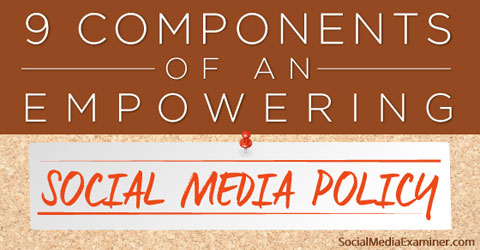 Does your company have a social media policy?
Does your company have a social media policy?
Are employees confused about what they can and can't post?
Social media policies must meet company and legal requirements, but should include open opportunities for employees to support your social media efforts.
In this article you'll discover how to create a social media policy that unleashes employee participation.
Why a Social Media Policy?
Research shows that a majority of employees are willing to share company information—they're just not sure what to share because they don't want to get in trouble.

A constructive company-wide social media policy will answer questions and encourage employees to add support on social media whenever possible.
The goal of this article is to help you develop a policy that is welcoming, not overwhelming. Here are nine components of an effective, empowering social media policy.
#1: Consider Corporate Culture
Your corporate culture has been built over years. It defines company beliefs, behaviors and expectations. Keep that in mind as you prepare to write (or rewrite) a social media policy.
Find out which other company policies (e.g., HR and IT) may overlap with your new social media efforts.
Whether those existing policies cover confidential information, harassment, technology, recordkeeping or other activities, be sure you know which ones you're expected to integrate into the social media tenets.
The question now becomes how do you plan to incorporate those (possibly strict) policies with a new policy meant to encourage more employee engagement on social media?
The company's existing expectations must carry over into the new policy to avoid confusion, over-sharing and company risk.
#2: Get Executive and Departmental Buy-In
Set up a meeting and invite major stakeholders within your organization and delegates from the necessary departments. At the minimum, make sure to have representatives from human resources, legal, communications and information technology.
During the meeting, discuss the policy writing and approval process. Emphasize the potential of socially active employees—the importance of sharing product announcements and launches, possible front-line listening and engagement and sharing recruiting announcements.
Get World-Class Marketing Training — All Year Long!
Are you facing doubt, uncertainty, or overwhelm? The Social Media Marketing Society can help.
Each month, you’ll receive training from trusted marketing experts, covering everything from AI to organic social marketing. When you join, you’ll also get immediate access to:
- A library of 100+ marketing trainings
- A community of like-minded marketers
- Monthly online community meetups
- Relevant news and trends updates
Re-emphasize your points by sharing success stories from businesses with socially empowered employees like Dell, Cisco or others related to your niche.
#3: Determine the Scope
A well-written policy starts with a firm plan. Defining the scope of your social media policy guides the entire process and any subsequent changes.
Answer these questions: Does the company want multiple policies to address various departments and networks; one combined detailed policy; or one general policy to apply to the company as a whole?
As you're deciding, keep in mind that the policy you're writing is for “general employees.” There should be a separate policy that applies solely to the social media team (with extra leeway since they're heading up the projects). The social media team's policy should include at least a style guide, playbook and internal strategy.
You can leave these special provisions out of your general policy to keep it short.
#4: Research State and Federal Laws
Navigating how state and federal laws affect your company's social media policy takes time, but it is imperative. You don't want to be fined for not abiding by the law.

Research the NLRB and other federal labor laws that may protect social media posts. The Federal Trade Commission has rules on how to make disclosures for endorsements, reviews and other situations where product or payment is made for social mentions. Other laws prohibit non-disparagement clauses in online customer contracts.
Keep an eye out for concerns from your stakeholders and department heads. For instance, as some companies develop social media policies, they claim they need access to employees' personal social media usernames and passwords to ensure company confidentiality is kept.
Eighteen states have enacted laws that prohibit employers from requesting usernames or passwords: Maine and Wisconsin (2014); Arkansas, Colorado, Illinois, Nevada, New Jersey, New Mexico, Oregon, Utah, Vermont and Washington (2013); California, Delaware, Illinois, Maryland, Michigan and New Jersey (2012).
The National Conference of State Legislatures has some of the best details on states enacting and considering these laws. The National Labor Relations Board “protects the rights of employees to act together to address conditions at work, with or without a union, including discussions on social media for such purposes.”
In short, make sure you talk to your legal department to ensure you're not infringing on employee rights.
#5: Clarify Policy Rules
Your goal, of course, is to empower employees to be active on social media channels and support the company in positive ways. As you move forward, you may find that employees are often willing to help share company information, but may not know what to share or how.

Discover Proven Marketing Strategies and Tips
Want to go even deeper with your marketing? Check out the Social Media Marketing Podcast! Publishing weekly since 2012, the Social Media Marketing Podcast helps you navigate the constantly changing marketing jungle, with expert interviews from marketing pros.
But don’t let the name fool you. This show is about a lot more than just social media marketing. With over 600 episodes and millions of downloads each year, this show has been a trusted source for marketers for well over a decade.
You can help them by clarifying known issues and asking them for additional questions about social media.

Crowdsourcing those questions ensures everyone is on the same page. For instance, you may think employees have questions about whether to share particular web pages, when in fact they have more basic questions—should they like the company Facebook page? Can the company see or mandate their personal posts?
Answer the most common questions in your document.
#6: Address Professional and Personal Use
There are a host of questions to consider regarding professional and personal use of social media. When can employees use social media during the workday? Are they allowed to post personal updates during business hours (e.g., during lunch or on a break)?
Define the extent of acceptable social media use in the office. Some companies have dual policies based on employee type—e.g., back-office and administrative professionals are able to use social during business hours, but hourly employees are not.

Departments directly involved with social media marketing should have provisions that allow them to access social media channels as needed.
Address whether employees need to disclose their association with the company when posting company information. Include acceptable posting standards for people who could be seen as representing your company on social media.
Encourage appropriate personal updates (after hours) when including company references. Remember, you can't regulate what employees do in their free time, but you can make suggestions.
#7: Keep it Short
So far you've consulted with key players; researched company policy, state and federal laws; collected employee questions; and established guidelines for social media use during business hours.
That much information could easily fill a binder or two. For your extensive policy that's fine—and you should have a copy of it housed in the appropriate departments.
However, if you distribute that comprehensive policy to employees, it's unlikely they'll read it—it will end up on a shelf somewhere gathering dust.
More importantly, if the social media guidelines are over two pages, most employees will probably be confused and will be less likely to engage in the company's social media efforts.
Distill the larger policy into short, easy-to-understand guidelines. In fact, Ford has a single page that covers the most important parts of its overall policy.
KPG created a four-minute video that explains their social media guidelines. The first two minutes familiarize employees with social media and how it's used for important communication with customers. At the 2:30 mark they succinctly state how to represent the company on those channels.
My tip for reducing the size of your policy: Rather than including specific rules about confidentiality, harassment or other areas already covered by existing policies, briefly mention them and encourage employees to read those policies separately.
Avoid complex rules so employees are empowered rather than confused.
#8: Train Employees
Even after you distribute a short version of your social media guidelines, you'll need to take the time to train employees.
That training will undoubtedly include frank discussions on limitations. Break up any perceived negativity by including inspiring and empowering elements.

Make social media relevant to employees by explaining that it's actually good for business—it helps speed sales cycles and increase close rates. Employees may not realize that the average Facebook user is in their 40s—not their 14s.
Including these elements helps motivate employees to get started on social.
#9: Launch the Social Media Policy
Do you like cake? Of course—everybody does. Have a social media policy launch party to get people excited and raise awareness about your renewed focus on employee engagement.
Give out prizes for people already involved in social. You can even gamify participation by creating a social media tracker on the Intranet. Recognize top social media stars in company emails or send out prizes (if you have the budget).
If you make it fun, people will want to participate!
Over to You
Crafting a social media policy that meets company and legal limitations, empowers employees and is short and sweet is quite an undertaking.
Managing its development requires listening to a number of contributors and distilling the important parts into a short, easily understood policy that reduces risk for the company and gives employees the freedom to support the company.
The new policy can be a rallying cry to help employees across the organization understand social media, increase activity and help create a more socially active company.
What do you think? Have you created a company social media policy? What items did you include? Let us know in the comments below!
Handshake photo, Law Keyboard photo, Crowdsource photo, Voting photo and Training photo from Shutterstock.
Attention Agency Owners, Brand Marketers, and Consultants

Introducing the Marketing Agency Show–our newest podcast designed to explore the struggles of agency marketers.
Join show host and agency owner, Brooke Sellas, as she interviews agency marketers and digs deep into their biggest challenges. Explore topics like navigating rough economic times, leveraging AI, service diversification, client acquisition, and much more.
Just pull up your favorite podcast app, search for Marketing Agency Show and start listening. Or click the button below for more information.

